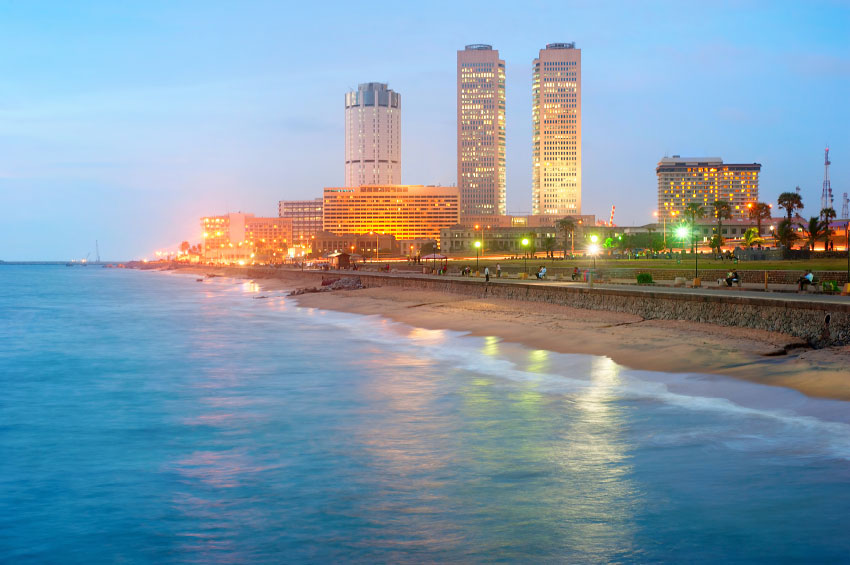East Asian nation lags behind competing economies and sets a growth target of $50 billion in exports.

When the Ceylon Chamber of Commerce convened a two-day economic summit last month its mission was simple, pick the brains of its participants for ideas on how to reboot Sri Lanka’s economy with a focus on increasing its export potential.
Easier said than done for a country that is still picking up the pieces after a nearly three-decade long civil war that claimed thousands of lives and devastated its economy and infrastructure. The pitch brochure to delegates, which included economists, policy makers and business leaders, laid out the many challenges ahead. Sri Lanka’s economy lags behind competing nations in the region, diversification of its export products and markets have reflected little progress, and its economy is overly vulnerable to external shocks.
The country needs foreign dollars that come with a thriving export economy to rebuild its infrastructure and stimulate job growth. From the 1970s to 1990s, exports made up 30% of GDP, that’s down by half since the turn of the century. Countries like Singapore, Taiwan, Malaysia and Thailand are outperforming Sri Lanka. Ready for a change in strategy, the Prime Minister of Sri Lanka kicked off the summit with a keynote speech highlighting initiatives for economic reform. “It is imperative to raise Sri Lanka’s export income in order to achieve significant sustainable economic development and an income of $50 billion U.S. or more is an achievable goal following a systematic approach to export development,” said Prime Minister Ranil Wickremesinghe. “To achieve this goal a concept of highly competitive social market policy with sustainable development will be implemented.”
The Prime Minister promised more policy changes through new legislation that would lower taxes, combat corruption and develop a competitive workforce.
“We will establish a new technical education system to upgrade skills from the craft level to degree level,” he said. “All programs will be island wide to expand English language skills. A voucher system will be introduced to provide grants and credit to students engaged in higher education studying technical, vocation and degree courses.”
Despite significant challenges, Sri Lanka’s return to political stability is inspiring optimism for economic growth. “This is the most propitious set of circumstances Sri Lanka has had in a long time,” said Mangala P.B. Yapa, CEO and General Secretary of the Ceylon Chamber of Commerce. “One of the key benefits of having a vibrant export sector for a developing country such as Sri Lanka is the ability to add new well-paying and sustainable jobs on an on going basis.”
Sri Lanka is also looking forward to regaining its GSP plus status from the European Union, which had been withdrawn from Sri Lanka in 2010. The EU's "Generalized Scheme of Preferences" (GSP) allows developing countries to pay less or no duties on their exports to the EU, allowing them vital access to EU markets while waiving the fee. Under GSP plus the EU provides additional preferences – beyond standard GSP treatment – to economically vulnerable developing countries like Sri Lanka, if they agree to abide by a number of conventions in the fields of human and labour rights, sustainable development and good governance.
“If re-instated, the GSP plus facility will provide concessionary access for Sri Lankan exports, into the EU and will enhance the growth potential for the entire economy,” said Sarada De Silva, CEO of National Chamber of Exporters.
GSP plus status will provide a boost to Sri Lanka’s garment industry; apparel is its biggest export item. In 2014, bilateral trade between the EU and Sri Lanka exceeded $5 billion, clothing accounted for nearly half the revenue.
Sri Lanka is also pushing to get the EU’s ban on Sri Lanka’s fish exports lifted by the end of the year. The EU imposed the ban, which went into effect in January after the government failed to demonstrate that it had sufficiently addressed illegal fishing. According to the Department of Commerce the penalty had cost Sri Lanka nearly $100 million in revenue, where it used to be the second largest exporter of fresh and chilled swordfish and tuna to the European Market.
Since the ban Ministry of Fisheries had implemented the majority of the procedures required by the EU and is hoping to resume exports with duty relief.
Sanctions relief in Iran could mean a lift to the country’s tea exports. Banking restrictions over Iran’s nuclear program drove up costs by forcing exporters to seek alternate ways to be paid. Before the international community imposed the sanctions in 2008, Iran was the largest overseas market for Sri Lanka’s tea.
0 COMMENTS